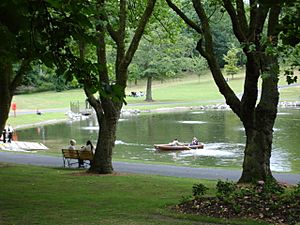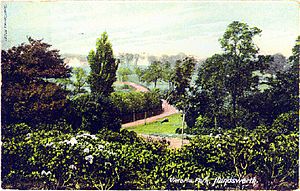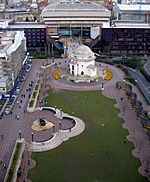Parks and open spaces in Birmingham facts for kids
Did you know that Birmingham is one of the greenest cities in Europe? It has an amazing 591 parks and open spaces! That's over 3,500 hectares (about 13.5 square miles) of green areas for everyone to enjoy. These parks are super important for the city, offering places to relax, play, and connect with nature.
The most important parks in Birmingham are called the five Premier Parks. Many parks, 15 of them, have even won a special award called the Green Flag Award. This award shows they are well-managed and great places to visit. Birmingham also has several special areas set aside to protect nature, including local and national nature reserves.
One of the most popular spots is Cannon Hill Park. It's huge, covering 250 acres! Here you can find different types of areas, from pretty gardens to wild woodlands and sports fields. You can go boating, fishing, play tennis, or just have a picnic. The biggest park of all is Sutton Park, which is 2,400 acres. It's actually the largest urban nature reserve in Europe! Close to the city centre, you can also visit the beautiful Birmingham Botanical Gardens. These gardens were created a long time ago, in Victorian times, and have a lovely conservatory. Another cool garden nearby is the Winterbourne Botanic Garden, looked after by the University of Birmingham.
Contents
Why We Have Public Parks
Public parks started appearing in the 1830s. Back then, many people lived in crowded industrial towns like Birmingham. City leaders hoped that parks would help people stay healthier and happier. They thought parks could reduce sickness, crime, and social problems. Parks were also seen as "green lungs" for the city, providing fresh air and places for people to have fun.
Most of the land for these early parks was either bought by the city council or given as gifts. Some parks were even created to celebrate special events, like the Queen's Jubilees. For example, Victoria Park and Queens Park were named to mark royal celebrations. Even the area around the NEC exhibition centre has free public park areas with wildlife and pretty lily ponds!
Birmingham's Premier Parks
Birmingham has five main parks that are considered the best of the best. These "Premier Parks" offer a wide range of activities and natural beauty for everyone.
- Cannon Hill Park
- Handsworth Park
- Kings Heath Park
- Lickey Hills
- Sutton Park
Did you know that King's Heath Park also has a special training facility for gardening and plant care? It works with Pershore College to teach people about horticulture.
Nature Reserves in Birmingham
Nature reserves are special places where plants and animals are protected. Birmingham has many of these important areas, helping local wildlife to thrive.
- Birmingham EcoPark
- Bromwich Wood Local Nature Reserve
- Harborne Nature Reserve
- Hill Hook Local Nature Reserve
- Kings Norton Local Nature Reserve
- Moseley Bog Local Nature Reserve
- Park Hall Nature Reserve
- Plants Brook Local Nature Reserve
- Queslett Local Nature Reserve
- Rubery Cutting Local Nature Reserve
- Sutton Park National Nature Reserve
Public Squares in the City Centre
Besides parks, Birmingham's city centre also has many open areas called public squares. These are great places for people to meet, relax, and enjoy city life. Some well-known squares include Centenary Square, Chamberlain Square, and Victoria Square.
The historic Old Square is located on Corporation Street. Newer squares like Rotunda Square and St Martin's Square can be found within the Bullring Shopping Centre. The area called Brindleyplace also has three squares and is home to the National Sea Life Centre.
Birmingham's Parks Strategy
In 2006, the Birmingham City Council created a big plan for the city's parks. This plan, called the "Parks Strategy," aims to make sure that Birmingham has a fantastic network of high-quality parks and green spaces for everyone who lives in or visits the city. It shows how important these green areas are for the future of Birmingham.




